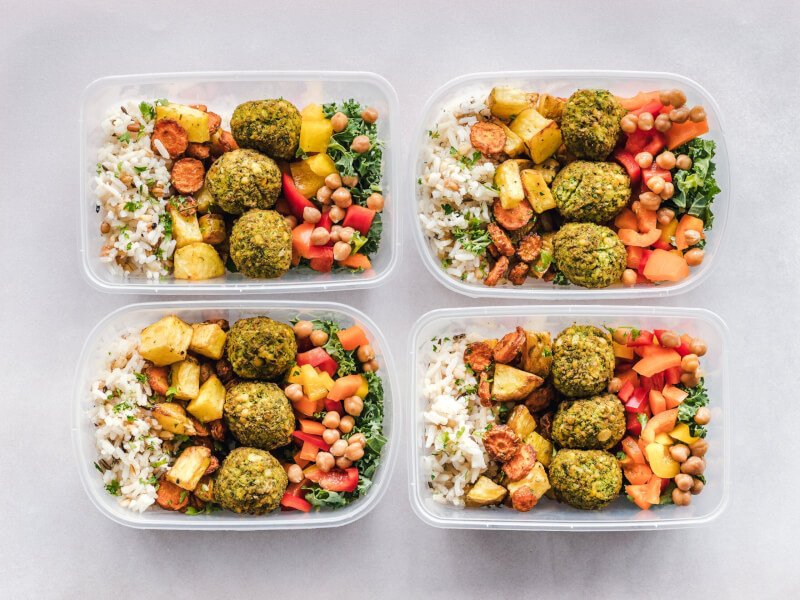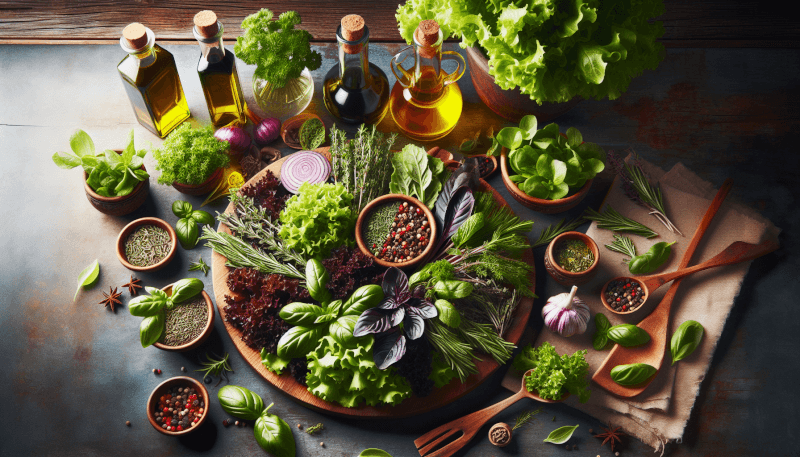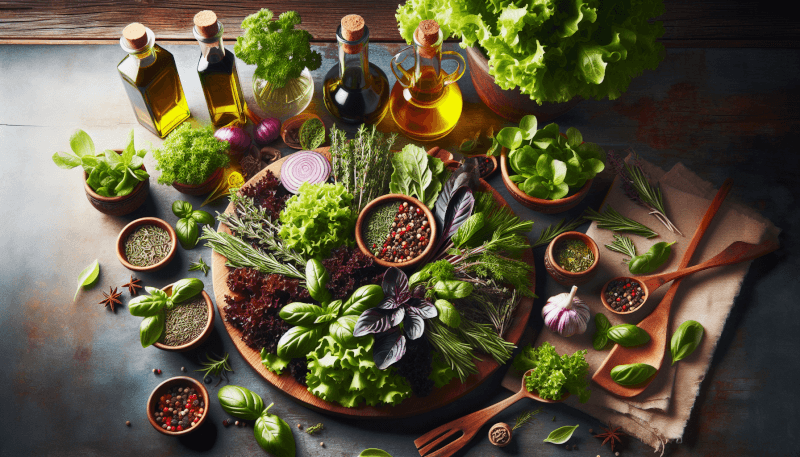In this article, discover the ultimate guide on how to incorporate fresh herbs into your healthy garden recipes. Whether you’re just starting your garden or have a flourishing one, learning the best ways to use these aromatic plants will elevate your culinary creations to a whole new level. With a friendly tone and practical tips, you’ll find inspiration to infuse your dishes with the vibrant flavors and medicinal benefits of fresh herbs. From simple salads to decadent desserts, there’s no limit to the delightful combinations you can create. Let’s embark on this flavorful journey together, shall we?

Benefits of using fresh herbs in healthy garden recipes
Fresh herbs not only bring delicious flavor and enticing aroma to your dishes but also offer numerous health benefits. Let’s explore the top advantages of using fresh herbs in your healthy garden recipes.
Enhances flavor and aroma
One of the most significant benefits of using fresh herbs is their ability to enhance the flavor and aroma of your dishes. Unlike dried herbs, fresh herbs have a vibrant and potent taste that can take your recipes to the next level. By adding a handful of chopped basil to your pasta sauce or sprinkling some fresh cilantro over your tacos, you can elevate the taste and create a delightful culinary experience.
Boosts nutritional value
In addition to their flavor-enhancing properties, fresh herbs also provide a wealth of nutrients. They are packed with essential vitamins, minerals, and antioxidants that are beneficial for your overall health. Adding fresh herbs to your recipes not only increases the nutritional value but also introduces a variety of flavors and textures to your meals.
Adds color and visual appeal
Fresh herbs can do wonders when it comes to adding color and visual appeal to your dishes. The vibrant green leaves of herbs like parsley, mint, and dill can instantly brighten up any plate. By garnishing your dishes with fresh herbs, you not only make them visually appealing but also make your meal look more appetizing and enticing.
Selecting and harvesting fresh herbs
Using fresh herbs starts with selecting the right ones and harvesting them properly. Let’s discover some useful tips for choosing the right herbs for your recipes and harvesting them from your garden.
Choosing the right herbs for your recipes
When selecting herbs for your recipes, consider the flavor profile you want to achieve. Each herb has a distinctive taste that pairs well with certain types of dishes. For example, basil is excellent for Italian and Mediterranean dishes, while cilantro adds a fresh and zesty touch to Mexican and Asian-inspired recipes. Experiment with different herbs to find the ones that complement the flavors of your favorite dishes.
Tips for harvesting herbs from your garden
Harvesting herbs from your garden ensures that you have a steady supply of fresh ingredients for your recipes. To harvest herbs properly, follow these guidelines:
- Choose the right time: Harvest herbs in the morning when the flavor and aroma are at their peak.
- Use sharp scissors or pruners: Cut the herbs just above a set of leaves or a node to encourage new growth.
- Trim from the top: Start trimming from the top of the plant to promote healthy growth.
- Don’t remove more than one-third: Avoid harvesting more than one-third of the plant to allow it to regenerate.
- Wash and pat dry: Rinse the harvested herbs under cold water, gently pat them dry, and use them immediately or store them properly.

Storing and preserving fresh herbs
To enjoy the flavors of fresh herbs for an extended period, proper storage and preservation techniques are necessary. Let’s delve into the best practices for storing and preserving your precious herbs.
Proper storage techniques
For short-term storage, you can keep fresh herbs in water, much like a bouquet of flowers. Simply place the stems in a jar with an inch of water and cover the herbs loosely with a plastic bag. This method keeps them hydrated and fresh for a few days.
If you want to store herbs for a longer time, consider the following techniques:
- Refrigeration: Wrap the herbs loosely in a damp paper towel and store them in a plastic bag in the refrigerator. This method can keep herbs fresh for up to two weeks.
- Herb keeper: Using an herb keeper allows you to store herbs upright, keeping them fresher for a more extended period.
- Herb-infused oils: Infusing herbs into oils is another excellent way to extend their shelf life while infusing the oil with their flavors. Store the infused oil in a tightly sealed bottle in a cool, dark place.
Freezing herbs for future use
Freezing herbs is a convenient method to preserve their freshness and flavors when you have a surplus. Follow these steps to freeze your herbs effectively:
- Rinse the herbs under cold water and pat them dry.
- Remove the leaves from the stems and chop or leave them whole, depending on your preference.
- Spread the herbs in a single layer on a baking sheet lined with parchment paper and freeze for a few hours.
- Transfer the frozen herbs to a freezer-safe bag or container and label it with the herb’s name and date.
- When needed, take out the desired amount and return the rest to the freezer immediately.
By freezing your fresh herbs, you can enjoy their flavors even during the off-season.
Drying herbs for long-term preservation
Drying herbs is a traditional method of preserving them for an extended period. Here’s how you can dry your herbs effectively:
- Gather the herbs in small bunches, securing them at the stems with a rubber band.
- Hang the bunches upside down in a well-ventilated, warm, and dry area away from direct sunlight.
- Allow the herbs to dry completely, which usually takes about one to two weeks.
- Once the herbs are dry, gently strip the leaves from the stems and store them in airtight containers.
- Place the containers in a cool, dry place away from direct sunlight.
Dried herbs can be used in various recipes, such as soups, stews, and marinades, throughout the year, allowing you to enjoy the flavors of your garden even during the colder months.
Using fresh herbs in salads and dressings
Salads are a fantastic canvas for incorporating fresh herbs. The marriage of crisp greens, vegetables, and the aromatic burst of herbs can create a sensational culinary experience. Let’s explore how you can use fresh herbs to bring your salads and dressings to life.
Creating herb-infused salads
To create herb-infused salads, start by selecting a variety of fresh herbs that complement the flavors of your greens and vegetables. Consider herbs like mint, basil, dill, parsley, and cilantro, as they add vibrant flavors and refreshing notes to any salad. Chop the herbs finely and toss them with your salad greens and vegetables for an instant burst of freshness.
For a unique twist, try adding delicate herbs like chamomile or lemon balm to your salad for a subtle floral touch. These herbs work particularly well in fruit salads, creating a harmonious balance of flavors.
Crafting homemade herb dressings
Homemade herb dressings are a simple yet effective way to add depth and complexity to your salads. Experiment with combining different fresh herbs, such as basil, thyme, oregano, and rosemary, to create unique flavor profiles. Mix the herbs with olive oil, vinegar or citrus juice, garlic, and a touch of honey, then whisk together until well blended.
Tasty variations include a zesty lemon and thyme dressing, a tangy balsamic and basil vinaigrette, or a refreshing mint and lime dressing. These homemade dressings allow you to savor the full potential of fresh herbs while avoiding added preservatives and artificial flavors.
Refreshing herb salsa recipes
Salsas are a versatile addition to any meal, whether as a dip, a topping, or a side. By incorporating fresh herbs into your salsa recipes, you can take them to a whole new level. Here are a few herb salsa ideas to tantalize your taste buds:
- Cilantro and lime salsa: Combine chopped cilantro, minced red onion, diced tomatoes, fresh lime juice, and a pinch of salt for a vibrant and zesty salsa that pairs well with grilled meats, tacos, or as a topping for avocado toast.
- Mint and cucumber salsa: Create a refreshing salsa by combining finely chopped mint leaves, diced cucumber, minced garlic, lemon juice, and a drizzle of olive oil. This salsa is perfect for serving with grilled seafood, lamb dishes, or as a dip for pita chips.
- Basil and tomato salsa: Mix diced tomatoes, minced basil leaves, red wine vinegar, a splash of olive oil, and a sprinkle of crushed red pepper flakes for a classic and flavorful salsa. Enjoy it with crusty bread, as a topping for bruschetta, or as a condiment for grilled chicken or fish.
Herb salsas offer a burst of fresh flavors and can transform any dish into a vibrant culinary masterpiece.

Incorporating herbs into soups and stews
Soups and stews are comforting and nourishing dishes, and fresh herbs can elevate their flavors to new heights. Let’s explore the various ways you can incorporate herbs into your favorite soups and stews.
Flavorful herb blends for soup bases
Herb blends are an excellent way to infuse soups and stews with layers of flavor. Experiment with different combinations of herbs to create a unique blend that complements the ingredients of your soup. Here are some classic herb blends for common types of soups:
- Italian herb blend: Mix dried or fresh basil, oregano, thyme, rosemary, and parsley for a flavorful blend that works well in tomato-based soups, minestrone, or vegetable soups.
- Herbes de Provence: Create an aromatic blend by combining dried or fresh thyme, rosemary, savory, marjoram, and oregano. This blend adds a distinct French flair to soups like bouillabaisse or ratatouille.
- Tuscan herb blend: Blend dried or fresh sage, rosemary, thyme, and oregano for a robust and earthy blend that complements bean-based soups, hearty stews, or Tuscan vegetable soups.
Adding these herb blends to your soups not only enhances their flavors but also fills your kitchen with delightful aromas.
Adding herbs as garnishes
Garnishing soups and stews with fresh herbs not only adds a pop of color but also imparts a burst of flavor and freshness. Consider these herb garnishes for your favorite soups:
- Chopped parsley: Sprinkle freshly chopped parsley over creamy soups or hearty stews for a bright and herbaceous finish.
- Chives: Finely chop chives and scatter them over potato or corn chowder for a subtle onion flavor and a touch of vibrant green.
- Basil ribbons: Create elegant basil ribbons by stacking basil leaves, rolling them tightly, and slicing them thinly. Add the ribbons to tomato-based soups or grilled vegetable soups for a beautiful presentation.
Garnishing with fresh herbs not only enhances the visual appeal but also allows you to enjoy their delicate flavors and aromas in every spoonful.
Infusing herbs in stock recipes
Enhance the depth and complexity of your stocks by infusing them with fresh herbs. Whether you’re making a vegetable, chicken, or beef stock, adding a handful of herbs can make a significant difference. Simmer the herbs with the stock for an extended period to extract their flavors fully. Popular herbs for stock infusions include bay leaves, thyme sprigs, parsley stems, and rosemary.
By infusing your stocks with herbs, you create a flavorful foundation for a wide range of homemade soups and stews.
Herbs for marinades and sauces
Marinades and sauces are excellent vehicles for infusing your dishes with the flavors and aromas of fresh herbs. Let’s explore the best ways to incorporate herbs into your marinades and sauces.
Creating herb marinades for grilled meats
Marinating meats is a fantastic way to tenderize them and infuse them with mouthwatering flavors. Fresh herbs play a crucial role in creating delicious and aromatic marinades. Here are a few herb marinade ideas to try:
- Garlic and rosemary marinade: Combine minced garlic, chopped rosemary, lemon juice, olive oil, salt, and pepper for a fragrant and robust marinade that pairs well with lamb, chicken, or pork.
- Citrus and herb marinade: Mix lemon and orange zest, chopped thyme, basil, parsley, garlic, olive oil, and a touch of honey for a zesty marinade that works wonders with seafood, chicken, or vegetables.
- Spicy cilantro and lime marinade: Create a vibrant and tangy marinade by blending cilantro, lime zest and juice, red chili flakes, cumin, garlic, and olive oil. This marinade is perfect for grilled shrimp, chicken, or tofu.
Allow your marinated meats to sit in the refrigerator for at least a few hours or overnight to let the flavors fully develop, resulting in tender and delectable dishes.
Whipping up versatile herb sauces
Herb sauces offer endless possibilities to elevate your dishes. From creamy herb dressings to zingy herb pestos, let your creativity soar with these versatile sauces. Here are a few ideas to get you started:
- Chimichurri sauce: Blend fresh parsley, oregano, garlic, red wine vinegar, red chili flakes, olive oil, and a squeeze of lemon juice for a bright and tangy sauce that complements grilled steak, chicken, or roasted vegetables.
- Mint yogurt sauce: Combine fresh mint leaves, plain yogurt, lemon juice, minced garlic, and a pinch of salt for a refreshing and creamy sauce that pairs well with roasted lamb, grilled vegetables, or falafel.
- Basil pesto: Blend fresh basil leaves, toasted pine nuts, garlic, grated Parmesan cheese, olive oil, and a squeeze of lemon juice for a rich and aromatic sauce that can be used in pasta dishes, as a topping for grilled fish, or as a spread for sandwiches.
These herb sauces provide a burst of flavors that can take your dishes from ordinary to extraordinary.
Infusing herbs into homemade condiments
Homemade condiments offer a healthier and more flavorful alternative to store-bought options. By infusing them with fresh herbs, you can create customized condiments that suit your taste preferences. Here are a few examples:
- Herb-infused mayonnaise: Blend mayonnaise with finely chopped fresh herbs like basil, parsley, tarragon, or dill to create a creamy and flavorful spread for sandwiches or a dipping sauce for fries.
- Herb-infused mustard: Mix ground mustard seeds with white wine vinegar, a pinch of salt, and finely chopped herbs such as thyme, rosemary, or sage for a tangy and aromatic condiment that can elevate your sandwiches or grilled meats.
- Herb-infused ketchup: Combine ketchup with minced garlic, dried oregano, basil, and a splash of red wine vinegar to create a zesty and herbaceous ketchup that pairs well with burgers, fries, or meatloaf.
By infusing herbs into your homemade condiments, you can add a personal touch and enhance the flavors of your favorite dishes.

Fresh herbs in pasta and grain dishes
Fresh herbs can bring vibrancy and depth of flavor to pasta and grain dishes. Let’s explore the various ways you can incorporate herbs into your pasta, rice, and quinoa recipes.
Tossing herbs with pasta and grains
Adding fresh herbs to your pasta or grain dishes can enhance their taste and provide a burst of freshness. Here’s how you can do it:
- Pasta: After cooking your pasta, toss it with a mixture of fresh herbs like basil, parsley, and mint. The herbs will infuse their flavors into the warm pasta, giving it a delightful aroma and taste.
- Rice: Add a handful of chopped herbs, such as cilantro, dill, or chives, to cooked rice. These herbs not only liven up the dish but also add a touch of elegance to your rice-based recipes.
- Quinoa: Mix cooked quinoa with finely chopped herbs like parsley, dill, or thyme to create a light and refreshing side dish that pairs well with grilled meats or roasted vegetables.
By incorporating fresh herbs into your pasta and grain dishes, you can create flavorful and aromatic meals that are sure to impress your taste buds.
Using herbs in pesto and sauce recipes
Pesto and sauce recipes offer a versatile platform for showcasing the vibrant flavors of fresh herbs. Here are some ideas to inspire your culinary creations:
- Traditional basil pesto: Blend fresh basil leaves, pine nuts, garlic, grated Parmesan cheese, olive oil, and a sprinkle of salt and pepper to create a classic pesto that is perfect for tossing with pasta, drizzling over roasted vegetables, or spreading on sandwiches.
- Cilantro and lime sauce: Blend fresh cilantro, lime juice and zest, garlic, plain yogurt, and a touch of honey for a zingy and creamy sauce that can elevate your tacos, grilled fish, or roasted sweet potatoes.
- Mint and pea sauce: Puree fresh mint leaves, cooked peas, lemon juice, garlic, Greek yogurt, and a pinch of cumin for a refreshing and vibrant sauce that complements lamb dishes, roasted vegetables, or as a dip for crudités.
These herb-based sauces add a burst of flavors to your pasta and grain dishes, transforming them into restaurant-quality meals.
Herb-infused rice and quinoa dishes
Infusing herbs into rice and quinoa can give these humble grains a delightful twist and added complexity. Here are a few herb-infused rice and quinoa recipes to try:
- Lemon herb rice: Cook rice with lemon zest, finely chopped dill or parsley, and a touch of garlic for a bright and aromatic side dish that pairs well with grilled seafood or roasted chicken.
- Cilantro lime quinoa: Add freshly squeezed lime juice and chopped cilantro to cooked quinoa for a tangy and herbaceous grain dish that complements Mexican-inspired meals or can be served as a base for a grain bowl.
- Herbed wild rice pilaf: Mix cooked wild rice with sautéed onions, chopped thyme, rosemary, dried cranberries, and toasted almonds to create a fragrant and flavorful side dish that pairs well with roasted meats or can be enjoyed as a vegetarian main course.
These herb-infused rice and quinoa dishes can add a delightful twist to your meals, making them more exciting and satisfying.
Baking with fresh herbs
Fresh herbs aren’t limited to savory dishes – they can also add a unique and unexpected touch to your baked goods. Let’s explore the various ways you can incorporate herbs into your baking endeavors.
Herb-infused bread and rolls
Fresh herbs can impart their flavors and aromas to homemade bread and rolls, creating delightful and fragrant baked goods. Consider these ideas when baking with herbs:
- Rosemary focaccia: Knead fresh rosemary leaves into the dough for a rustic and aromatic bread that can be enjoyed on its own, as a base for sandwiches, or alongside soups and stews.
- Herb dinner rolls: Add finely chopped herbs like dill, chives, or parsley to the dough of your favorite dinner roll recipe. The herbs will infuse the rolls with delightful flavors and make them extra special.
- Cheese and herb scones: Incorporate a combination of shredded cheese, such as cheddar or Parmesan, and chopped fresh herbs into the scone dough for savory and aromatic scones that are perfect for breakfast or as a snack.
By incorporating herbs into your baking, you can add an unexpected twist to your favorite bread and roll recipes.
Savory herb pastries and pies
Fresh herbs can bring a burst of flavors and elevate the taste of savory pastries and pies. Consider these savory herb pastry ideas:
- Herbed cheese turnovers: Fill puff pastry squares with a mixture of cream cheese, chopped fresh herbs like basil or thyme, and a touch of garlic. Fold the pastry into triangles and bake until golden brown for a delectable and savory treat.
- Sage and onion hand pies: Create a filling with sautéed onions, fresh sage leaves, breadcrumbs, and a pinch of salt and pepper. Encase the filling in flaky pastry and bake until golden for a savory and satisfying handheld pie.
- Herb quiche: Combine various fresh herbs like tarragon, parsley, chives, or dill with eggs, cream, and cheese, then bake in a flaky pie crust for a savory and aromatic quiche that can be enjoyed for breakfast, brunch, or a light lunch.
These savory herb pastries and pies can make any meal special and showcase the vibrant flavors of fresh herbs.
Adding herbs to cakes and cookies
Herbs can add a unique touch to cakes and cookies, creating unexpected flavor combinations that are sure to surprise and delight. Here are a few ideas to explore:
- Lavender and lemon cookies: Incorporate dried lavender flowers and freshly grated lemon zest into buttery cookie dough for delicately flavored and aromatic cookies that are perfect for afternoon tea or as a sweet treat.
- Rosemary and olive oil cake: Infuse a moist and tender cake with finely chopped fresh rosemary leaves and extra-virgin olive oil. The combination of herbal notes and the fruity aroma of the olive oil creates a memorable and elegant dessert.
- Basil and strawberry cupcakes: Add finely chopped basil leaves to a classic vanilla cupcake batter and top the baked cupcakes with fresh strawberry frosting. The subtle herbal notes complement the sweet and tangy strawberry flavors, creating a unique and delicious dessert.
These herb-infused cakes and cookies can amaze your taste buds and take your baking skills to a whole new level.

Innovative drinks with fresh herbs
Fresh herbs can bring a refreshing twist to your beverages, whether you’re crafting cocktails, mocktails, infused water, or herbal tea. Let’s explore the innovative ways you can incorporate herbs into your drinks.
Herb-infused cocktails and mocktails
Herb-infused cocktails and mocktails are a fantastic way to enjoy the flavors and aromas of fresh herbs while refreshing your palate. Here are a few ideas to inspire your cocktail creations:
- Mint julep: Muddle fresh mint leaves with a touch of sugar and lime juice, then add bourbon, crushed ice, and a sprig of mint for a classic and refreshing cocktail that’s perfect for summer.
- Basil lemonade mocktail: Blend freshly squeezed lemon juice, basil leaves, honey, and sparkling water for a vibrant and herbaceous mocktail that will quench your thirst on a hot day.
- Rosemary gin fizz: Combine gin, freshly squeezed lemon juice, simple syrup, and a sprig of rosemary. Shake with ice and strain into a glass, then top with sparkling water for a botanical and effervescent cocktail experience.
These herb-infused cocktails and mocktails can elevate your social gatherings or simply add a touch of sophistication to a relaxing evening.
Refreshing herb-infused water recipes
Infusing water with fresh herbs is an excellent way to stay hydrated and enjoy the subtle flavors and aromas of herbs. Here are some refreshing herb-infused water recipes to try:
- Cucumber and mint water: Add thinly sliced cucumbers and a handful of fresh mint leaves to a pitcher of water. Let it infuse in the refrigerator for a few hours before serving for a refreshing and cooling drink.
- Citrus and rosemary water: Squeeze the juice of a few lemon or orange slices into a jug of water, then add a sprig of fresh rosemary. Allow it to infuse in the refrigerator overnight, and wake up to a revitalizing and fragrant beverage.
- Strawberry basil water: Muddle fresh basil leaves with strawberries and add them to a pitcher of water. Allow it to sit for a few hours to infuse the flavors together, resulting in a subtly sweet and herbaceous drink.
These herb-infused water recipes are not only delicious but also encourage you to increase your daily water intake.
Herbal tea variations
Herbal teas are a soothing and comforting beverage choice, perfect for both relaxation and health benefits. Here are some herbal tea variations to explore:
- Chamomile and lavender tea: Combine dried chamomile flowers and lavender buds for a calming and aromatic tea that can help promote relaxation and a restful sleep.
- Peppermint and lemon balm tea: Blend dried peppermint leaves with lemon balm for a refreshing and uplifting tea experience. Enjoy it hot or iced for a revitalizing pick-me-up.
- Ginger and turmeric tea: Combine freshly grated ginger and turmeric with boiling water for an invigorating and immune-boosting tea that can help soothe digestion and reduce inflammation.
Herbal teas allow you to fully enjoy the therapeutic properties of fresh herbs, providing comfort and wellness in every sip.
Conclusion
Incorporating fresh herbs into your healthy garden recipes brings a multitude of benefits. From enhancing the flavors and aromas to boosting the nutritional value and adding visual appeal, fresh herbs are a game-changer in the culinary world. Whether you’re tossing them in salads, infusing them in soups and sauces, or adding them to baked goods and beverages, fresh herbs can take your dishes to new heights. So, unleash your creativity and savor the diverse flavors that fresh herbs have to offer in your next garden-to-table meal. Your taste buds and overall well-being will thank you for it!


